📘 Educational Psychology: Essential Concepts for Reading Comprehension
Overview: Educational psychology explores how individuals learn and develop, emphasizing cognitive, emotional, and social processes. It provides insights into teaching methods, learning challenges, and motivational strategies that optimize educational outcomes. RC passages on this topic often analyze foundational theories, instructional frameworks, and interventions for effective learning. Mastering these concepts enables readers to critically evaluate and apply educational practices across diverse contexts.
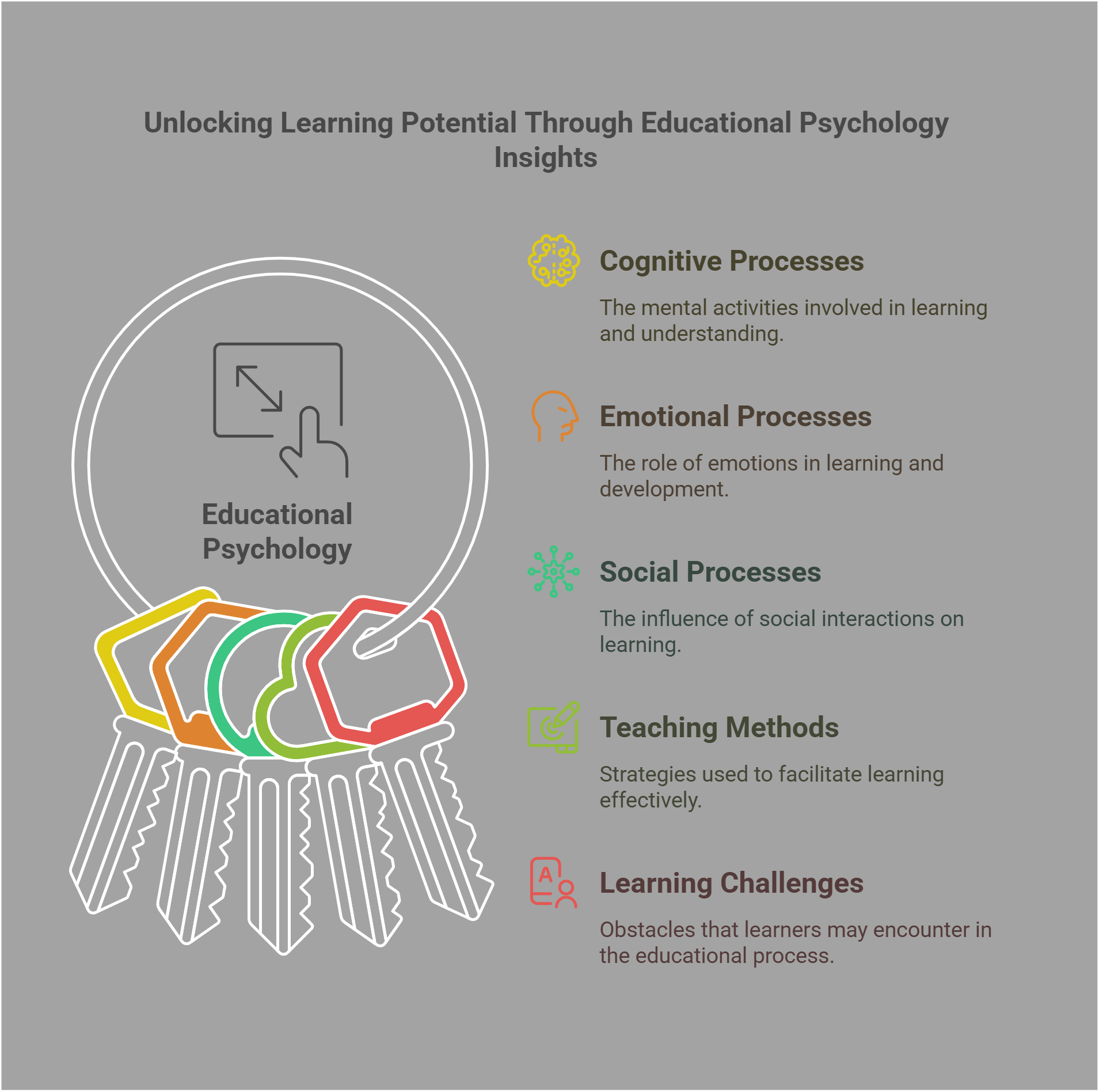
🔑 Key Concepts
This guide delves into the following essential concepts in educational psychology:
- Constructivist Learning
- Scaffolding
- Zone of Proximal Development
- Bloom’s Taxonomy
- Self-Determination Theory
- Learning Disabilities
- Formative Assessment
- Motivation Theories
- Collaborative Learning
- Metacognition
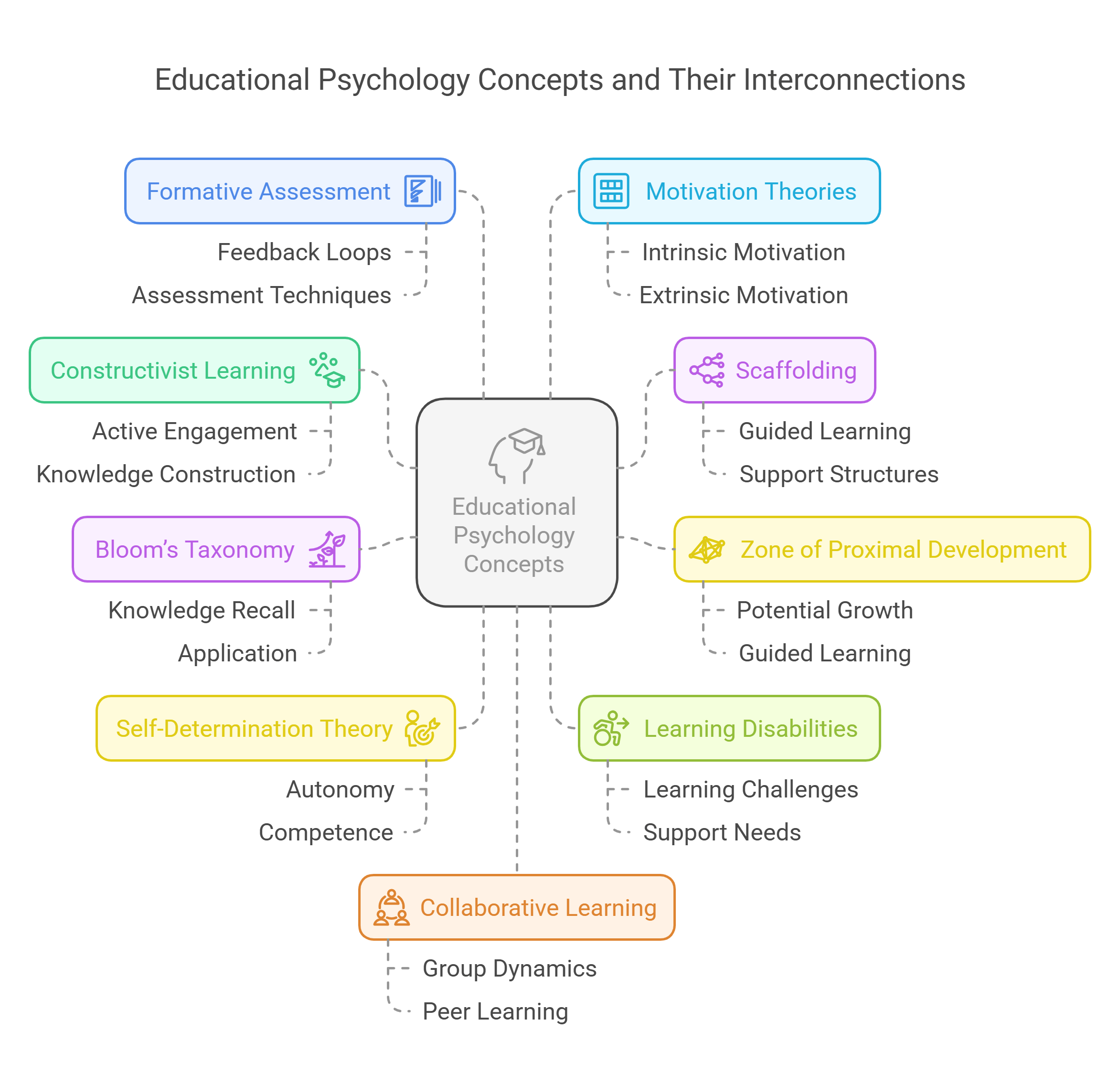
1. Constructivist Learning
Detailed Explanation: Constructivist learning theory, rooted in the work of Jean Piaget and Lev Vygotsky, posits that learners actively construct knowledge by engaging with their environment, building on prior experiences, and integrating new information.
- Core Principles:
- Active Learning: Learners are not passive recipients but active participants in the learning process.
- Contextual Learning: Knowledge is better understood and retained when tied to real-world applications.
- Social Interactions: Collaboration and dialogue enrich understanding.
- Applications:
- Inquiry-based learning, where students explore and solve real-world problems.
- Class discussions that encourage critical thinking and idea sharing.
Example: A science teacher guiding students to design their own experiments based on a hypothesis they develop.
Explained Simply: Constructivist learning is like building a house—each new concept forms a brick in the structure of understanding.
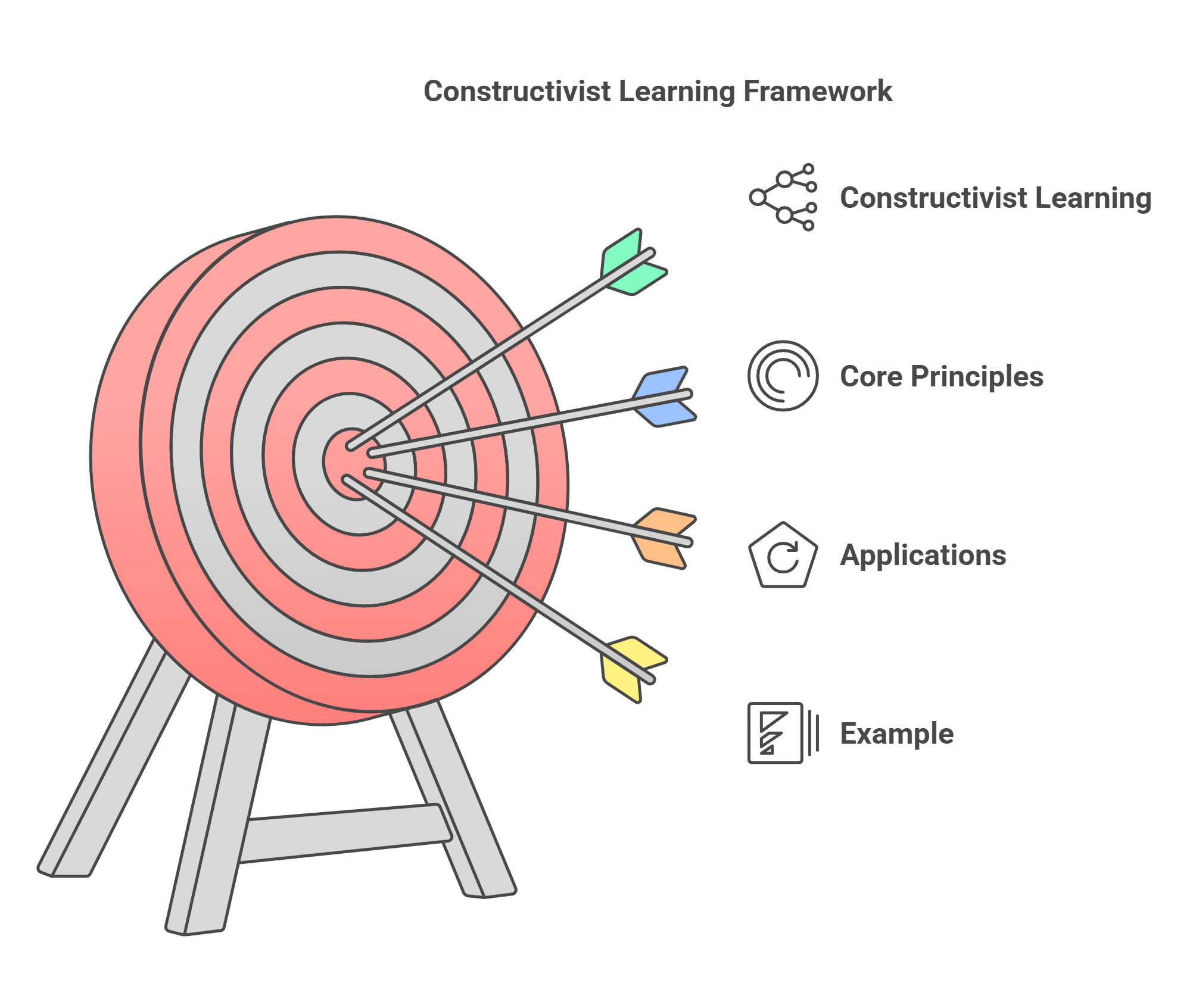
2. Scaffolding
Detailed Explanation: Scaffolding, introduced by Jerome Bruner and influenced by Vygotsky’s theories, describes the temporary support provided by teachers or peers to help learners achieve tasks beyond their independent capabilities. This support is gradually reduced as the learner gains competence.
- Key Techniques:
- Simplifying tasks into manageable steps.
- Offering visual aids, hints, or examples.
- Encouraging self-reflection to internalize learning.
- Applications:
- A teacher guiding students through essay writing by initially providing templates and prompts, then encouraging independent drafting.
Explained Simply: Scaffolding is like training wheels on a bike—essential at first but removed once confidence grows.
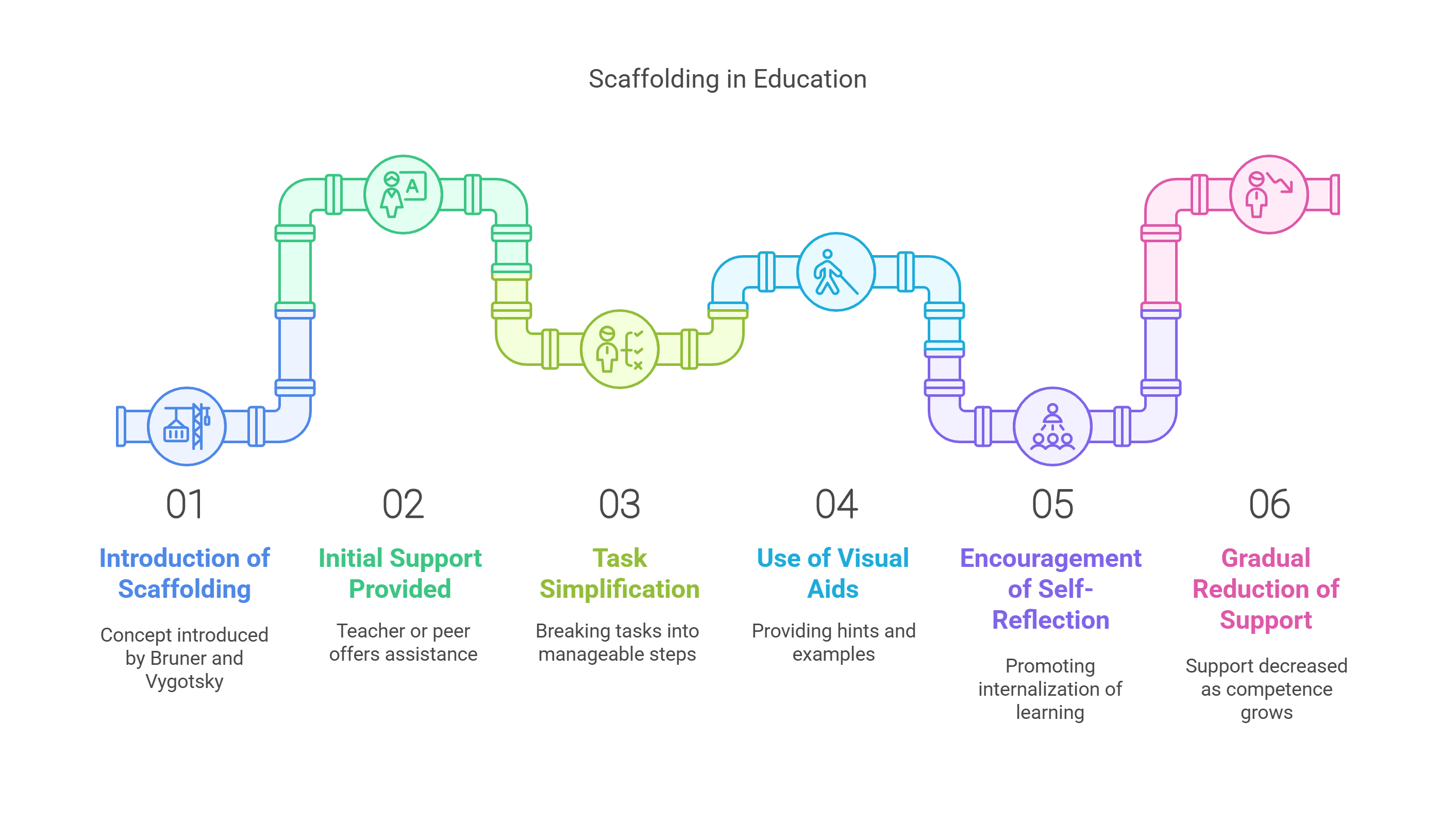
3. Zone of Proximal Development (ZPD)
Detailed Explanation: Proposed by Lev Vygotsky, the ZPD refers to the gap between what a learner can do independently and what they can achieve with guidance. It highlights the importance of providing targeted assistance to maximize learning potential.
- Key Features:
- Tasks Below the ZPD: Easily accomplished, offering little growth.
- Tasks Within the ZPD: Achievable with support, fostering development.
- Tasks Above the ZPD: Too challenging, causing frustration.
- Applications:
- Tailoring instruction to provide appropriate levels of challenge, such as using differentiated activities for students with varying abilities.
Example: A child struggling with multiplication tables progresses when a teacher uses visual aids and interactive games for support.
Explained Simply: The ZPD is like a ladder—help from others helps learners climb to the next step of understanding.

4. Bloom’s Taxonomy
Detailed Explanation: Developed by Benjamin Bloom, this framework categorizes educational goals into hierarchical levels, encouraging progression from basic knowledge acquisition to higher-order thinking.
- Revised Levels (2001):
- Remembering: Recalling facts or information.
- Understanding: Explaining concepts or ideas.
- Applying: Using knowledge in practical scenarios.
- Analyzing: Breaking down information into components.
- Evaluating: Making judgments based on criteria.
- Creating: Producing original work by synthesizing ideas.
Applications: Designing curriculum and assessments to ensure progression from foundational skills to critical thinking.
Example: A history teacher begins by asking students to list key events (remembering), then analyze their causes and effects (analyzing).
Explained Simply: Bloom’s Taxonomy is like climbing a cognitive staircase, starting with simple tasks and advancing to complex ones.
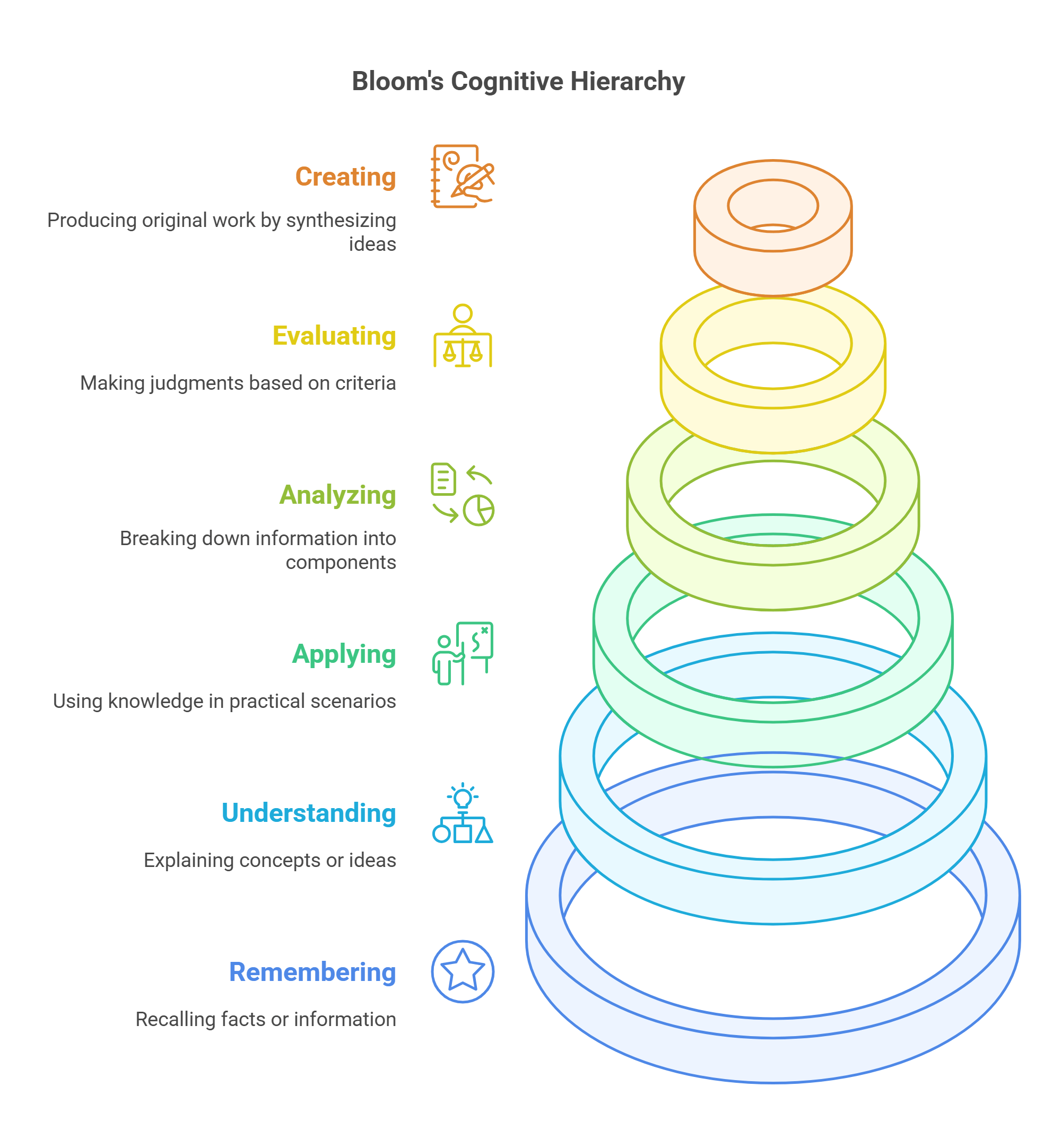
5. Self-Determination Theory (SDT)
Detailed Explanation: SDT, proposed by Deci and Ryan, explores how intrinsic and extrinsic motivation influences behavior and learning. It emphasizes three psychological needs:
- Autonomy: The need to feel in control of one’s actions.
- Competence: The need to feel capable and effective.
- Relatedness: The need to feel connected to others.
Key Insights: Intrinsic motivation (e.g., learning for curiosity) is more sustainable and effective than extrinsic motivation (e.g., learning for rewards).
Applications: Creating classroom environments where students have choices and feel empowered.
Example: Allowing students to choose topics for their projects fosters autonomy and engagement.
Explained Simply: SDT is like fueling motivation with purpose, confidence, and connection.
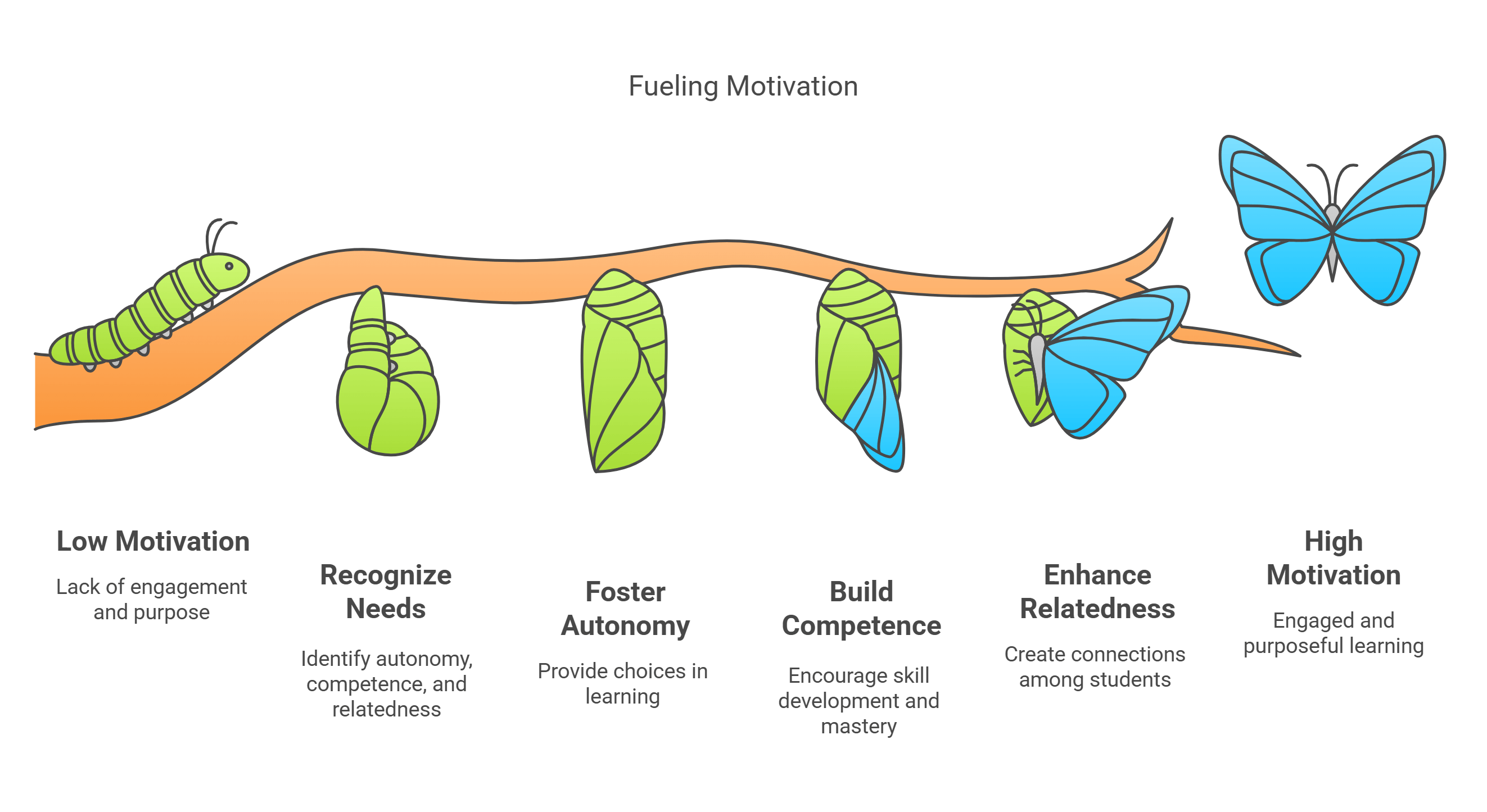
6. Learning Disabilities
Detailed Explanation: Learning disabilities are neurological disorders that affect a person’s ability to acquire specific skills, despite normal intelligence and opportunities.
- Types:
- Dyslexia: Difficulty with reading and language processing.
- Dyscalculia: Difficulty understanding numbers and mathematical concepts.
- Dysgraphia: Difficulty with writing.
Key Strategies:
- Individualized instruction tailored to specific challenges.
- Using assistive technologies like text-to-speech software.
Example: A student with dyslexia benefits from audiobooks and extended time for assignments.
Explained Simply: Learning disabilities are like roadblocks that require customized detours for success.
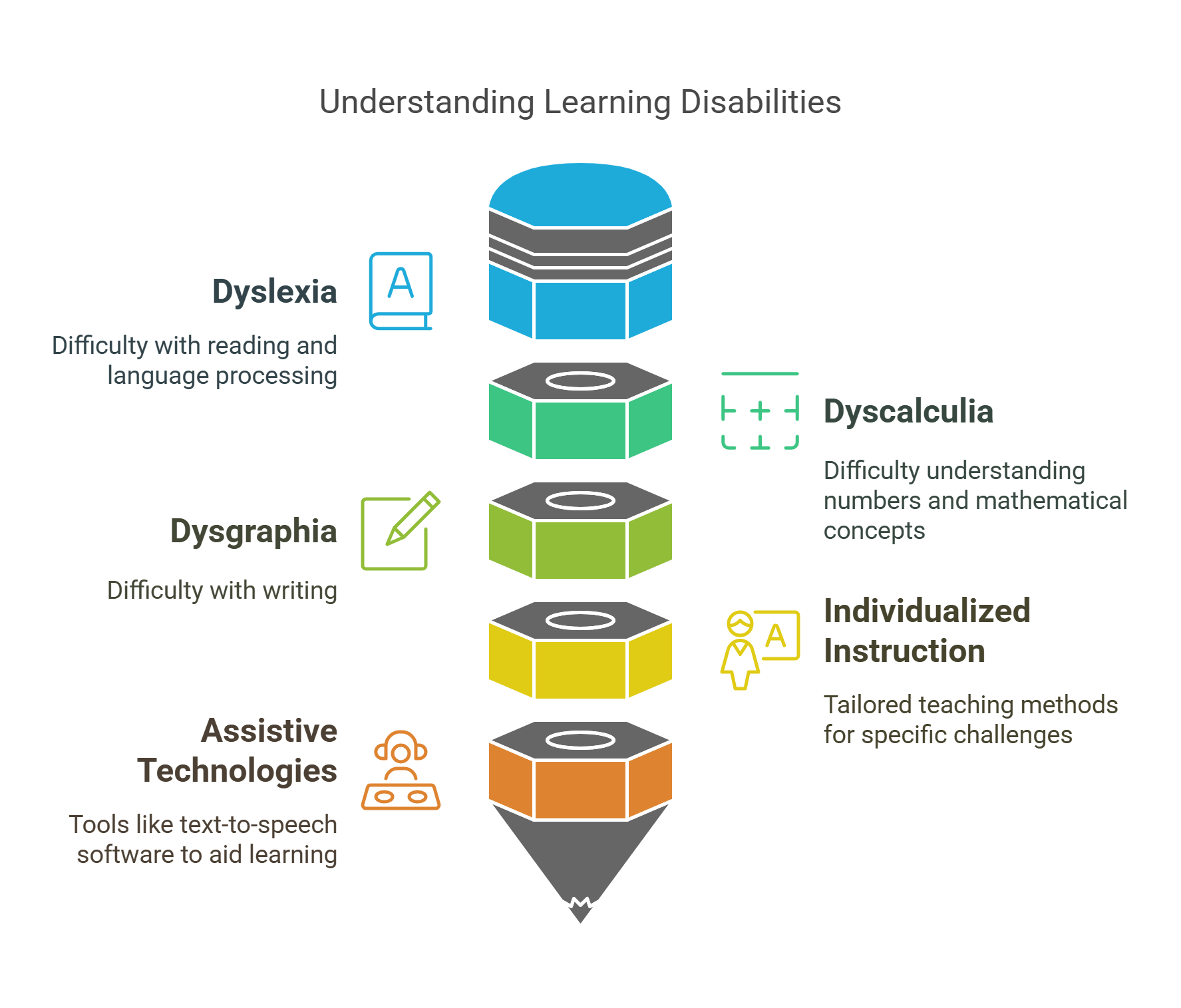
7. Formative Assessment
Detailed Explanation: Formative assessment involves regular feedback and evaluations during the learning process to guide improvements and inform instruction.
- Key Features:
- Non-graded assessments to reduce pressure.
- Frequent feedback loops to track progress.
Applications: Teachers using quizzes, peer reviews, or class discussions to adjust teaching strategies.
Example: A science teacher reviewing student lab notebooks weekly to provide constructive feedback.
Explained Simply: Formative assessment is like a compass, guiding students toward their learning goals.

8. Motivation Theories
Detailed Explanation: Motivation theories explore the internal and external factors that drive learners.
- Key Types:
- Intrinsic Motivation: Driven by curiosity and interest.
- Extrinsic Motivation: Driven by rewards or external pressures.
- Expectancy-Value Theory: Motivation depends on the perceived value of the task and confidence in success.
Applications: Designing lessons that balance fun activities (intrinsic) with recognition and rewards (extrinsic).
Example: A student is motivated to study science because they enjoy experiments (intrinsic) and want good grades (extrinsic).
Explained Simply: Motivation theories explain what gets students excited to learn.
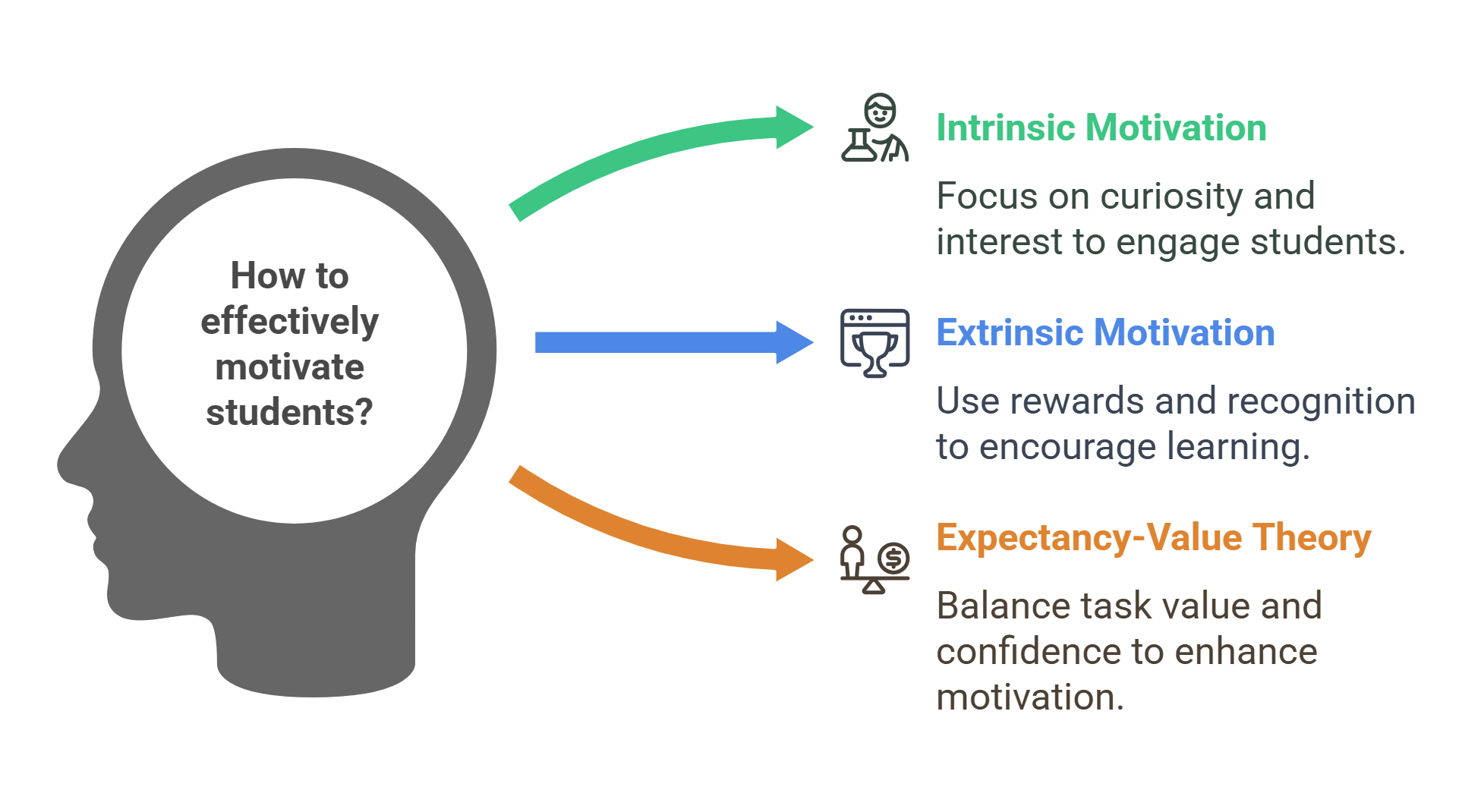
9. Collaborative Learning
Detailed Explanation: Collaborative learning emphasizes teamwork and shared goals, leveraging group dynamics to enhance understanding.
- Key Benefits:
- Encourages peer-to-peer learning.
- Develops communication and critical thinking skills.
- Challenges:
- Requires effective group management to avoid unequal participation.
Example: A group project where students research a topic, divide responsibilities, and present findings collectively.
Explained Simply: Collaborative learning is like building a puzzle as a team—each member contributes pieces to complete the picture.

10. Metacognition
Detailed Explanation: Metacognition, often referred to as “thinking about thinking,” involves being aware of and controlling one’s cognitive processes during learning. It includes understanding how you learn best, monitoring your progress, and adjusting strategies to achieve your goals. Metacognition is critical for developing independent learners who can adapt to challenges and improve performance over time.
- Components of Metacognition:
- Metacognitive Knowledge: Awareness of one’s cognitive strengths and weaknesses, as well as understanding effective strategies for different tasks.
- Metacognitive Regulation: The ability to plan, monitor, and evaluate one’s learning processes.
- Reflection: Continuously analyzing what worked, what didn’t, and why.
- Key Strategies for Metacognition:
- Planning: Setting clear objectives and choosing appropriate study methods before starting a task.
- Monitoring: Continuously assessing comprehension and progress while working on a task.
- Evaluating: Reviewing results to determine if learning goals were achieved and how methods can be improved.
Applications:
- Encouraging students to use reflective journals to document their learning experiences and strategies.
- Teaching self-questioning techniques, such as “Do I understand this concept?” or “How can I approach this differently?”
- Using graphic organizers to help learners visualize their thought processes.
Example: A student preparing for an exam evaluates their study techniques, realizes rote memorization isn’t working, and switches to summarizing key points in their own words.
Explained Simply: Metacognition is like having an internal GPS for learning—it helps you track where you are, decide the best route, and adjust course when needed to reach your destination efficiently.
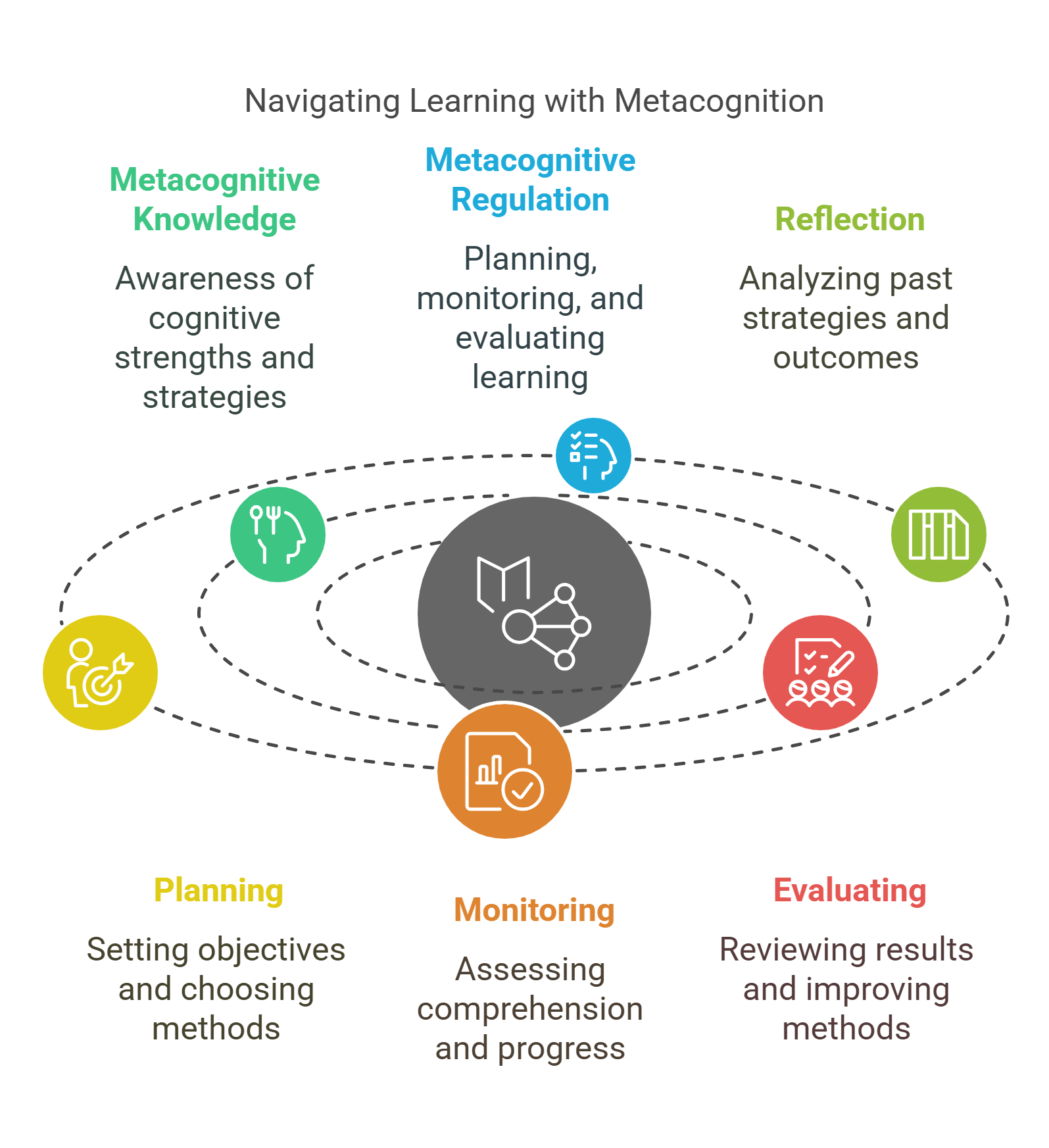
✨ Conclusion
Educational psychology bridges theory and practice, offering tools to enhance learning outcomes and foster personal growth. By understanding concepts like scaffolding, Bloom’s Taxonomy, and self-determination theory, readers can critically engage with RC passages and explore effective teaching methods. This field empowers educators and learners alike to navigate the complexities of education with deeper insight and purpose.










